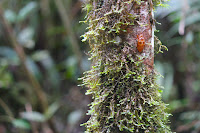 UNESCO declared it as a World Heritage site in 2000. I was at 2 other World Heritage sites in April: Angkor Wat temples and Luang Prabang.
UNESCO declared it as a World Heritage site in 2000. I was at 2 other World Heritage sites in April: Angkor Wat temples and Luang Prabang. We didn’t see 5000 species of plants, although we saw a LOT. The usual epiphytes, lianas and ferns, but I did learn about some of their different types. We saw the world’s tiniest orchid and one worth USD10,000 because it’s so rare.


The signs around the park were different colours symbolising which plants were endemic (native to the place), common, or medicinal.




Don the guide kept telling us the long species names of plants, like Nepenthes X. Kinabaluensis and Nepenthes Villosa, for different types of Pitcher plants. How are we meant to remember these? (BTW - I copied these from a book). AND he kept telling us numbers, like how many different types of rattan vines there are, or how many types of orchids there are. What is the point of telling us that when we don’t know how many there are in the world. He should have used percentages, like more than 50% or about 20% etc.
 |
| USD10,000 orchid |
Spencer St John worked for the British Crown in the mid 19 century, and in in 1858 he wrote that he found a gigantic pitcher plant which held 4 liters of water and one that contained a dead rat. Pitcher plants are carnivorous - obviously with dead rat decomposing in it.








How big was the pitcher plant you saw?
ReplyDelete